| |
Lecture on RWH for ECO CLUB schools in New Delhi
CSE delivered a lecture on RWH in a programme organised Government
Girls Senior Secondary School, Kalkaji, New Delhi, (an Eco Club lead
school identified by Government of Delhi) on December 12, 2003. The
target group included teachers and students from 15 government schools
of Delhi.
CSE's lecture focused primarily on water management and rainwater
harvesting. The talk outlined the water scarcity in India and reasons
of scarcity amidst plentiful rains. Uncontrolled exploitation, rampant
usage, polluted water resources are not new in most of the urban areas.
Concepts and principles of RWH was explained by narrating the rich
traditions of rainwater harvesting that existed in India right from
the Indus valley civilization. Starkling experiences from CSE's Model
RWH were also shared during the occasion.
Manoj Dabas, Regional Director (North), Ashoka Trust For Reasearch
on Environment and Ecology (ATREE) delivered a lecture on Environment,
education and biodiversity. The Programme was focused to introduce
the students and teachers, the varied environmental problems.
TSRDS organises a workshop in Ghato Tand, in
Jharkhand
A workshop on rooftop rainwater harvesting was organised by Tata Steel
Rural Development Society (TSRDS) in Ghato Tand, West Bokaro District
on December 3, 2003. The participants included villagers from the
four watershed areas of Mandu Block (Kusum Daha Jal Chajan Pariyojna
(JCP), Bonghara JCP, Tirlanal JCP and Chainpur- Atna JCP) and the
contractors working in the area.
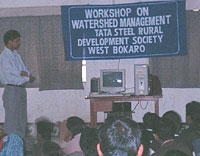 Prolonged mining and lack
of water conservation activities has adversely affected the hydro-geological
regime of the area. This is clear from the fact that despite receiving
an annual average rainfall of 1400 milli metre, these villages do
not have enough water for drinking or irrigation. Most of the chappakals
(handpumps) in the area have failed. So is the case with open wells,
which serves 90 per cent of the drinking water requirement of the
villagers. Prolonged mining and lack
of water conservation activities has adversely affected the hydro-geological
regime of the area. This is clear from the fact that despite receiving
an annual average rainfall of 1400 milli metre, these villages do
not have enough water for drinking or irrigation. Most of the chappakals
(handpumps) in the area have failed. So is the case with open wells,
which serves 90 per cent of the drinking water requirement of the
villagers.
The CSE staffer sensitized the participants on the need for adopting
rooftop rainwater harvesting at the household level which can ensure
water availability during lean periods. RWH techniques like storage
and groundwater recharge, the implementation strategies and precautions
to be taken were discussed in detail.
Release of English and Marathi versions of
RWH manuals for Mumbai
On December 6, 2003 Mohan Dharia, former Cabinet Minister and President,
Vanarai Trust, a Puna based NGO released the English version of Mumbai
specific How to do water harvesting manual, published by CSE at a
seminar in IIT Powai. This manual provides basic information on the
water scenario, hydro-meteorology, RWH techniques and case studies
from Mumbai. The seminar titled “Jal Sangrah Shibir” was
organised by alumnus of the IIT Powai with the objective of sensitising
the professionals as well as other individuals on the water related
issues and the concept of RWH. CSE also conducted a workshop on urban
rainwater harvesting with the success stories from Mumbai and Delhi
highlighting the issues related to implementation, maintenance and
monitoring. Subraba Marathe, Asssitant Engineer, Municipal Corporation
of Greater Mumbai (MCGM), who spoke on the occassion highlighted the
initiatives of MCGM in spreading the concept of RWH. Builders and
architects who are involved in water harvesting in Mumbai also shared
their experiences with the participants. At the end the participants
charted out a “Powai Declaration ” as an outcome of the
two day workshop. This declaration highlighted the main issues that
need to be addressed in the future to make water resources sustainable.
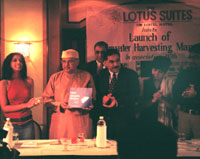 The
Marathi version of the manual was released by the Kiran V. Shantaram,
Sheriff of Mumbai on December 9, 2003 in a workshop organised jointly
by CSE, United States –Asia Environmental Partnership (USAEP)
and Hotel Lotus Suites. The participants included the members of Rotary
Inner wheels, Advanced Locality Management (ALM) Group (who looks
after the welfare of residential colonies) and individuals. During
this seminar Vithal Kamat, Chairman, Kamat Group of Hotels announced
the launching of first Raincentre in Mumbai at Lotus Suites hotel
in collaboration with CSE. The
Marathi version of the manual was released by the Kiran V. Shantaram,
Sheriff of Mumbai on December 9, 2003 in a workshop organised jointly
by CSE, United States –Asia Environmental Partnership (USAEP)
and Hotel Lotus Suites. The participants included the members of Rotary
Inner wheels, Advanced Locality Management (ALM) Group (who looks
after the welfare of residential colonies) and individuals. During
this seminar Vithal Kamat, Chairman, Kamat Group of Hotels announced
the launching of first Raincentre in Mumbai at Lotus Suites hotel
in collaboration with CSE.
The focus of CSE lecture in both the seminars was the relevance of
water conservation in general and RWH in particular to overcome the
water crisis in Mumbai. It also highlighted the mechanisms required
to popularise this concept as well as the policy interventions that
would lead to Jal Swaraj-water independence in Mumbai.
For more:
CSE's
presentation on Mumbai's water status
Mumbai Specific
RWH Manual"Water
scenario in Mumbai alarming"
Huge potential for RWH in Jharkhand
CSE in its key note address on "Water 2003- Water Resources Management
and Conservation" organised by the Confederation of India Industry
(CII), Jharkhand state council in association with department of water
resources, government of Jharkhand on December 8, 2003 at Ranchi highlighted
the potential of rainwater harvesting (RWH) inmitigating water scarcity
in the state. During the presentation, CSE's representative emphasised
on the conflicting situation of scarcity amidst plenty as far as Jharkhand
water is concerned. The state is blessed with plenty of rain--1400
milli metre (mm)--16 river basins; and 29,335 ponds and tanks. Yet,
Jharkhand faces acute water problems. All its 22 districts were declared
drought affected in 2002. The situation was quite grim in 2003 too,
with 113 blocks in 13 districts facing acute water crisis.
CII in association with department of water resources, government
of Jharkhand organised this seminar with an objective to initiate
a water management and conservation movement in Jharkhand to overcome
the water problems. Experts from different parts of the country were
invited to share their experiences with politicians, bureaucrats,
water engineers, members from non-governmental organisation (like
United Nations Children's Fund and Dahod based N M Sadguru Water and
Development Foundation), academia and research institutes (like Jadavpur
University and International Water Management Institute) and interested
citizens.
Harnath Jagawat of N M Sadguru Water and Development Foundation (NMSWDF)
shared his experiences of initiating a water conservation interest
and work in the tribal areas of Gujarat and Rajasthan. His presentation
focused primarily on the approach and techniques adopted by NMSWDF
to popularise water harvesting and in assessing the impact on the
villagers, ecological region and the resource per se.
In the inaugural session, the water resources secretary, government
of Jharkhand Sudhir Tripathy shared the plans of the state government
in addressing water-related issues. According to him, the state is
trying to increase the irrigation coverage through a mix of major,
medium, minor and groundwater development projects. He mentioned that
the state is working towards the restoration of the eroded irrigation
potential of existing schemes and by establishing irrigation network
and institutionalising participatory irrigation management approach
within the state. While talking on the issue of groundwater, Tripathy
mentioned that the state government would be launching the 'Gram Bagirathi
Yojana', with a total outlay of 10.24 billion rupees, developing 0.44
million hectare of land within the state. During his presentation
he categorically mentioned that this programme has taken into consideration
the principles propagated by CSE's Jal Swaraj campaign. According
to Tripathy, the state is also working towards
- Preparing model groundwater act and
- Establishing a state groundwater authority
The Jharkhand government will also be generating awareness on water
issues through a well thought out campaign strategy.
In his inaugural speech Ram Chandra Keshri, Minister for water resources,
Jharkhand highlighted the plans of the state government in addressing
the water issue. According to him 6 major and 17 medium projects,
developing 0.45 million hectare of land is in the pipeline. The
total outlay of the programme is 47 billion rupees. He also reiterated
the facts shared by Tripathy on the Gram Bagirathi Yojana.
For more information
Slide
show on Jharkhand's water status
Ghaziabad Development Authority (GDA) organises
a workshop on rainwater harvesting
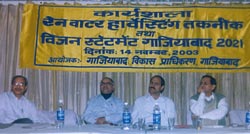 Inspired
by the latest order of the Government of Uttar Pradesh making rainwater
harvesting (RWH) systems mandatory in all buildings with a rooftop
area of 300 square metre, GDA organised a RWH workshop on November
14, 2003. D P Singh, Vice Chairman, GDA, in his inaugural address
briefed the participants, on the growing urban challenges of the city.
Professor Gauhar Mehmood, Jamia Milia Islamia University, discussed
the role of rivers in developing and distressing the civilizations
all over the world. He emphasized that RWH technique not only depends
on geology and hydrogeology but also engineering, landscaping, architecture
and others. Dr Mehmood also highlighted the problems of maintenance
of rainwater harvesting structures. In an audio-visual presentation,
CSE staffer presented the principles and concepts of rainwater harvesting.
He also unveiled the planning and designing aspects of rainwater harvesting
at individual as well as community level. S B Singh of the Central
Ground Water Board (CGWB) presented the trend of decline in water
table in Ghaziabad in the recent years. He also discussed the geology
of Ghaziabad region and availability of potential zones for ground
water recharge. Inspired
by the latest order of the Government of Uttar Pradesh making rainwater
harvesting (RWH) systems mandatory in all buildings with a rooftop
area of 300 square metre, GDA organised a RWH workshop on November
14, 2003. D P Singh, Vice Chairman, GDA, in his inaugural address
briefed the participants, on the growing urban challenges of the city.
Professor Gauhar Mehmood, Jamia Milia Islamia University, discussed
the role of rivers in developing and distressing the civilizations
all over the world. He emphasized that RWH technique not only depends
on geology and hydrogeology but also engineering, landscaping, architecture
and others. Dr Mehmood also highlighted the problems of maintenance
of rainwater harvesting structures. In an audio-visual presentation,
CSE staffer presented the principles and concepts of rainwater harvesting.
He also unveiled the planning and designing aspects of rainwater harvesting
at individual as well as community level. S B Singh of the Central
Ground Water Board (CGWB) presented the trend of decline in water
table in Ghaziabad in the recent years. He also discussed the geology
of Ghaziabad region and availability of potential zones for ground
water recharge.
SERIES OF AWARENESS PROGRAME AT MUMBAI BETWEEN
13TH - 15TH OCTOBER, 2003
I. Training Programe For Plumbers
The Brihan Mumbai Licensed plumbers Association (BMLPA) organised
the workshop for plumbers on 15th of October, in which around 70 plumbers
from various parts of Mumbai attended. The programe was conducted
at Juhu Jagruti Hall, Opp to N M College, Vile-Parle.
Mr Gandhi, president of the plumber association inaugurated the workshop.
The CSE's staffer during his presentation explained in detail the
various types of water harvesting structures and their construction
methodology. He also explained the various case studies from Delhi
and their impact on groundwater through PowerPoint presentation.
II. Exhibition Cum Workshop At Jamnabai Nursee School
A three day exhibition cum lecture on rainwater harvesting was
organised by Jamnabai Nursee school, Vile parle between 13th - 15th
of October 2003. The exhibition was jointed put up by CSE and Maharastra
Natural Park. The exhibition was mainly on water related issues. The
exhibition cum workshop was inaugurated by film actor Paresh Rawal.
Posters depicting traditional water harvesting practices and latest
techniques and case studies were put up in the exhibition. The Mahrastra
Natural Park has put up working model of rainwater harvesting in the
stall.
The workshop was attended by parents and student from the school.
The exhibition days started from 3 and ended at 6 PM and at the end
of the session a presentation on rainwater harvesting was done by
the CSE's staffer.
III. Workshop For Advanced Locality Management Group, (ALM)
A workshop for ALM was organised on 15th of October 2003 by Lotus
Suites and The United States Asia Environmental Partnership Program
(USAEP).
The United States Asia Environmental Partnership Program (USAEP) jointly
along with Briham Mumbai Corporation (BMC) has recently entered the
campaign and funding for rainwater harvesting in Mumbai. Its Deputy
Director Nutan Zarakar, is interest in campaigning for rainwater harvesting
along with CSE in Mumbai. The USAEP has also decided to fund the ALM's
for implementing water harvesting.
The Lotus Suites of Orchid Hotel has decided to run a sustained campaign
for the ALM programme of the Municipal Corporation of Greater Mumbai
(MCGM). The ALM is a unique concept initiated by the MCGM about two
years ago. Under this programme the residents of a particular area
or lane take up the cleaning and maintenance of that place.
In the workshop around 50 ALM's from various parts of Mumbai participated
in the workshop. In the presentation made by the CSE staffer he explained
the alarming water situation in Mumbai and explained to the participants
the case studies for Back Bay Bus Depo and Tata Institute of Social
science. He also explained the benefits of rainwater harvesting through
case studies from Delhi also.
Workshop on water for Kanpur schools
Members CSE Jal Swaraj members participated as resource persons in
a two-day workshop organised by the Kanpur-based NGO, Eco-friends,
on Sept. 27-28. More than 80 students from the 10 to 12th standard
from 29 Kanpur schools, together with several teachers, participated
in the workshop.
The workshop addressed five major themes: Ganga Action Plan; interlinking
of rivers; rainwater harvesting and drinking water quality. Students
actively participated, especially in staging a play that dealt with
mitigating the current water crisis.
Many eminent professionals and government personnel attended the various
sessions. During the first session on Ganga Action Plan (GAP), B P
Shukla, CPCB, F U Rahman, PPCU and Dr Padma, IIT Kanpur, highlighted
the ambitious plans, impact, failures and lessons learnt from implementing
GAP.
B P Shukla said that 35 % of total sewage generated has been tackled
in the first phase of the GAP. Using graphical presentations he explained
how the river water quality has improved significantly due to interception
of large quantities in Kanpur.
In his presentation on GAP, F U Rahman explained to the students the
changes that will take place under Indo Dutch Ganga Action Plan Support
Project. He said that by constructing the 200 MLD sewage treatment
plant on the bank of River Pandu, Kanpur would be the only city in
the central India, which treats the entire waster water before letting
it to Ganga.
Dr Padma explained to the children's about the failure of the GAP
in cleaning the river. She said that IIT Kanpur along with Eco Friends
had conducted an independent survey on the existing treatment plants
and ground water quality, which indicated the failure of GAP, as the
pollution level is high.
During the second session on River Interlinking, water and energy
expert Dr Sudhireendra Sharma, and Dr Bithin Datta, IIT Kanpur, spoke
about the political, social and economic issues involved in the extremely
ambitious Interlinking Rivers plan.
Dr Bithin Datta elaborated on the experiences of China and other countries
concerning interlinking of rivers, and underscored the high costs
involved -- estimated to about Rs. 560,000 crores - in implementing
such a project.
In response to a student's query, that this plan could bring agricultural
boom in the country, Sharma reiterated that the problem was not agricultural
productivity or water availability but equitable distribution of foodgrains
- something that this project cannot improve.
During the third session on rainwater harvesting initiatives, Chakresh
Jain, of the Kanpur Development Authority and CSE's R K Srinivasan,
led a discussion on the urgent need, benefits and requirements for
implementing rainwater harvesting in Kanpur. Students also viewed
a short public service film produced by CSE during this session.
CSE staff also cited the benefits of RWH initiatives in several Delhi
schools, and highlighted the important role played by schools, teachers,
students in spreading awareness on this issue. They also answered
several queries regarding the quality of stored water.
During the fourth session on drinking water quality, Dr R K Singh
of the Central Pollution Control Board, Kanpur and Dr Krishna Gopal
of the Industrial Toxicology Research Centre (ITRC), Lucknow discussed
common groundwater pollutants, and the pattern of groundwater pollution
in Kanpur. Dr R K Singh also explained how contaminated can travel
a long distance through underground aquifers only to show up after
10 or 15 years, making the task of cleaning up contaminated groundwater
extremely difficult.
Similarly, Dr Krishna Gopal spoke on various diseases caused by groundwater
contaminants, especially those caused by excess amounts of heavy metals
in the drinking water.
In ensuing interactive session, the experts stated that as 32 parameters
have to be tested, there is no one instrument available in the market
that could determine drinking water quality easily.
For the final session of the workshop, the students where divided
into six groups. The groups evaluated all they had learned during
the past two days. At the end of this session, the students developed
an action plan for the future.
The highlights of their Action Plan include:
- Proper laws should be made for water quality
- Water conservation effort should start from home
- The river interlinking issue should be looked on since it has
been successfully implemented in other countries.
- Rainwater harvesting should done in large scale.
- PIL should be filed against the GAP
- Student should not use poly bags in schools
- Untreated raw water should be used for non potable purpose.
- Proper planning and coordination must be developed among the
various departments.
- More awareness and more workshops must be done, and,
- Scientist must develop cost effective water purifying methods.
Training programme for New Delhi Municipal
Corporation (NDMC)
As part of its Jal Swaraj campaign, CSE organised a training programme
for New Delhi Municipal Council (NDMC) engineers at the Talkatora
Indoor Stadium in Delhi on September 25, 2003. The objective was
to sensitize the engineers on the technical aspects of water conservation.
This was essentially a follow up of CSE network meeting at the India
Habitat Centre in August where the NDMC officials requested CSE
to develop a rainwater harvesting master plan for the city. As a
follow-up a strategy was outlined for harvesting rainwater in the
entire 42 square kilometer area of NDMC, stretching from Paharganj
in the north, to Green Park in the south and Sundernagar in the
east to Dhaulakuan in the West.
The meeting commenced with Vijay Saluja's address on the significance
of rainwater harvesting in NDMC area. CSE staffers then spoke on CSE's
Jal Swaraj Campaign, their experiences of rainwater harvesting in
model projects, and explained the planning and designing aspects of
rainwater harvesting structures for both individual houses and large
colonies. The meeting threw up important facts and figures like the
number of dry tubewells and borewells, which can be used for groundwater
recharge while drawing up a plan for rainwater harvesting in NDMC
area.
Public awareness meeting at Sarita Vihar,
New Delhi
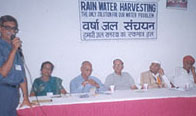 South
Delhi's Sarita Vihar colony is facing an acute water crisis. This
colony does not get municipal water supply. The demand is partially
met through several tube wells in the colony. Due to burgeoning
demand and over-extraction, the water level has fallen sharply and
the quality of water has rapidly deterioted. To mitigate the situation,
the Delhi Environmental Education Project (DEEP), a New Delhi-based
NGO, organised a public awareness meeting at Arya Samaj Mandir Hall
at G pocket of Sarita Vihar on September 14. Devendra Sahai, DEEP
director, underscored the lack of awareness among the residents,
and highlighted the need to create awareness about the importance
of rainwater harvesting. South
Delhi's Sarita Vihar colony is facing an acute water crisis. This
colony does not get municipal water supply. The demand is partially
met through several tube wells in the colony. Due to burgeoning
demand and over-extraction, the water level has fallen sharply and
the quality of water has rapidly deterioted. To mitigate the situation,
the Delhi Environmental Education Project (DEEP), a New Delhi-based
NGO, organised a public awareness meeting at Arya Samaj Mandir Hall
at G pocket of Sarita Vihar on September 14. Devendra Sahai, DEEP
director, underscored the lack of awareness among the residents,
and highlighted the need to create awareness about the importance
of rainwater harvesting.
The Chief Guest of the function, Dr Priyaranjan Trivedi, Chairman
of Indian Institute of Ecology and Environment, spoke about the
need for rainwater harvesting in Sarita Vihar. He expressed his
full cooperation to the Resident Welfare Society in getting the
project implemented, and in taking up the issue to higher officials
and to the Delhi chief minister.
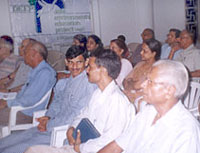 Dr
S B Singh of the Central Ground Water Board (CGWB) spoke about the
role of CGWB in taking care of groundwater quality and quantity
in Delhi. He stressed the need of having recharge wells inside storm
water drains, which reduce the size of storm water drains, reduction
on the cost of constructing big storm drains and also benefit recharging
groundwater. Dr
S B Singh of the Central Ground Water Board (CGWB) spoke about the
role of CGWB in taking care of groundwater quality and quantity
in Delhi. He stressed the need of having recharge wells inside storm
water drains, which reduce the size of storm water drains, reduction
on the cost of constructing big storm drains and also benefit recharging
groundwater.
In an audio-visual presentation on rainwater harvesting, R K Srinivasan
of CSE’s Jal Swaraj campaign, quoted the case study of Panchshila
Park colony, which stands out an ideal model for the group houses
in Delhi. He stressed the need for community-based rainwater harvesting
that costs less to implement than individual RWH initiatives and
benefits the entire community in a given area. The interactive session
at the end of the meeting was useful, and several queries from the
audience were addressed.
Save water - Our concern
A Seminar on Water Management was organised by Rotary International
District 3010, on 5th September, 2003 at Indian Habitat Centre, New
Delhi. DG Rajesh Batra, Distt.Governer of Rotary International, inaugurated
the meeting. He informed that the workshop was a curtain raiser for
the forthcoming international conference of water, which will be organised
by rotary in the month of December 2003.
The technical session included the presentation by Harnath Jagawat
of Sadguru Foundation, Dr Chakraborty, CGWB, and R K Srinivasan, CSE.
Harnath Jagawat in his presenataion narrated how his experiences on
water harvestingin the villages of Maharastra, Gujarat and Madya Pradesh.
The CSE staffer started with the ground water deteriotion condition
in Delhi and solution to the raising crisis. He narrated CSE experience
through the findings from model projects both quality wise and quantity
wise. The CGWB staffer explained the various techniques of rainwater
harvesting and methods of constructing the water harvesting structures.
After the presentation Sushil Gupta, the chairperson of the session
invited Krishen Saighal of Panchsheel Park Colony to narrate his water
harvesting experience. In his presentation he explained how the colony
came out to the water crisis with cost effective designs given by
CSE.
The seminar also extended invitation to the participants to attend
the Water Management conference proposed to be held at Vigyan Bhawan
on December 9-10, 2003.
Training programme for plumber and masons
As a part of its environmental programme Hotel Maurya Sheraton Hotel,
New Delhi, organised a training programme on September 1, 2003, in
collaboration with CSE. The target group was plumbers and masons.
About 25 Plumbers, masons, contractors, supervisors and engineers
from Maurya Sheraton, Hotel Mariot and interested plumber and masons
attended the workshop.
The workshop started with a brief introduction of the participants
followed by a slide show by Niranjan Khatri, Manager, Environment
Initiatives, Welcom group, on diverse aspects of water. In his speech
he insisted the need for urban rainwater harvesting the role the plumber
and mason can act in implementing the projects.
CSE staffer gave a presentation on different aspects of rainwater
harvesting including basic principles, need of the technology in present
context and specially the designing aspects. Through simple line drawings
he explained the methodology of constructing water harvesting structures.
Training Programme for plumbers and masons in New Delhi
CSE in collaboration with Centre for Media Studies, New Delhi, organised
an one day training programme for plumbers and masons on July 21,
2003. About 30 plumber and masons from different parts of Delhi attended
the workshop.
The objective of the programme was to impart training on the basics
and design aspects of rainwater harvesting and to generate the resource
base in implementation sector. Engineer from CSE provided technical
guidance to the plumbers who attended the meeting.
Niranjan Khatri, Manager, Environment Initiatives, Welcom group, during
his address presented the relation of environment with man and importance
of different components.
In his presentation, CSE staffer presented a comprehensive picture
of rainwater harvesting. He spoke on the basics principles of rainwater
harvesting. Specifications for making the structures and the precautions
to be taken during the implementation were discussed in detail. Performance
of the model rainwater harvesting projects were also discussed. He
spoke about he impacts of rainwater harvesting practice in these model
project in both water quality and quantity and in social mobilization.
Number of doubts and queries were cleared to participants.
After looking at the response and interest of participants CMS decided
that it would conduct series of similar training programme in different
parts of the city in near future.
ALTT Centre, Ghaziabad, organises a training programme for BSNL
Engineers
On August 6, 2003, Advanced Level Telecom Training Centre, Ghaziabad,
organised a training programme on rainwater harvesting. BSNL's Engineers,
Architects and Planners from different parts of country attended the
workshop. On this occasion CSE staffers made a presentation on rainwater
harvesting. The focus of the deliberation was "urgency of water
management and scope of rainwater harvesting in India". Participants
were given an introduction to the basics principles, planning and
design aspects of rainwater harvesting. Some case studies from Delhi,
Chennai, Bangalore and Mumbai were also discussed. Maintenance related
issues were also given the due attention.
Network Meeting
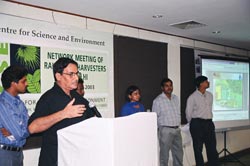 Centre
for Science and Environment organised a Networking meeting of rainwater
harvesters in the city on August 20, 2003 at India Habitat Centre.
The objective of the meeting was to take stock of RWH initiatives
in Delhi and to bring together individuals, organisations and government
agencies who are actively promoting and practicing this simple, people-friendly
technology. CSE also unveiled its new set of six model RWH projects. Centre
for Science and Environment organised a Networking meeting of rainwater
harvesters in the city on August 20, 2003 at India Habitat Centre.
The objective of the meeting was to take stock of RWH initiatives
in Delhi and to bring together individuals, organisations and government
agencies who are actively promoting and practicing this simple, people-friendly
technology. CSE also unveiled its new set of six model RWH projects.
The participants included hosts of CSE's Model Projects and citizens
who have implemented RWH under the technical guidance of CSE or other
agencies such as the Central Ground Water Board (CGWB) and the Delhi
Jal Board (DJB). Besides this, a large number of people who were keen
to acquire detailed information related to RWH also attended the meeting.
Representatives from concerned government departments, including the
Delhi Government's Bhagidari cell, the New Delhi Municipal Corporation
(NDMC), CGWB and the DJB took active part in the event.
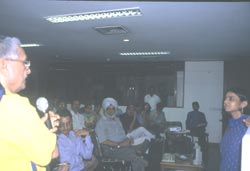 The
meeting began with Sumita Dasgupta, Coordinator of CSE's Natural Resource
Management, flagging some of the key issues and concerns related to
RWH. Access to relevant, viable technical information and authentic
cost estimates by reliable agencies; need for focused government policies
and incentives were some of issues that were put on the table. The
meeting began with Sumita Dasgupta, Coordinator of CSE's Natural Resource
Management, flagging some of the key issues and concerns related to
RWH. Access to relevant, viable technical information and authentic
cost estimates by reliable agencies; need for focused government policies
and incentives were some of issues that were put on the table.
Later CSE's technical expert, RK Srinivasan, presented the data on
quality and quantity of ground water in CSE's first set of five model
projects, monitored during the past one and a half years. CSE
also launched the next set of six-model rainwater harvesting projects.
These are:
1. Tihar Jail (Central Jail No.4) -Janakpuri, New Delhi
2. Indian Spinal Injuries Centre-Vasant Kunj, New Delhi
3. Mother's International School (Aurobindo Ashram)- Sri Aurobindo
Marg, New Delhi
4. Ford Foundation-Lodhi Road, New Delhi
5. Garden Estate- Mehrauli-Gurgaon Road, Gurgaon
6. Texcorp Ltd- Mohammadpur, Khandsa Road, Gurgaon
This was followed by a group discussion, led by CSE's director Sunita
Narain. A vibrant and interactive session of exchanging ideas, experiences
and opinions took place, with the government officials responding
to various queries raised by the people. People who have adopted RWH,
including CSE's model project hosts, also came up with some very effective
solutions to the problems that were identified by the group. Among
some of the critical points discussed were, maintenance of structures;
identifying sources of financial support; developing a standardised
monitoring process to assess impact; and the wide variation in the
costs of designs available.
Action plan:
The group concluded that such network meetings were absolutely imperative
to ensure that more citizens entered the fold of 'rainwater harvesters'.
And the initiative must be taken jointly, not by a particular organisation
or group. The following are salient features of the action plan that
was finalised at the end of the meeting:
1. The Delhi government will create a forum of rainwater harvesters
and will organise regular meetings;
2. The government will also arrange a meeting of technical experts
working in this field to develop standardised, cost effective RWH
systems;
3. A forum will be created including the representation of all schools.
4. A newsletter will be published to ensure regular flow of information
and act as a platform to share experiences. Madhu Bhatnagar, Vice
Principal, The Shri Ram School and Atul Bhalla, Vice Principal, Mira
Model School, will be Incharge of the newsletter and CSE will render
all kind of support.
Paani Ghano Anmol (Precious Water)
The research conducted by Janhit Foundation (JF), a Meerut based non
governmental organisation (NGO) with financial support from the Centre
for Science and Environment (CSE), points out that the deterioration
of ponds and johads (traditional water harvesting systems) is the
primary cause of Meerut's water woes. The study says "The district
is left with only 1944 out of 3062. Out these,1543 ponds are dry."
More than fifteen hundred wells 1540 out of 2086, are being used as
garbage dumps or as septic tanks posing a serious threat to groundwater
quality.
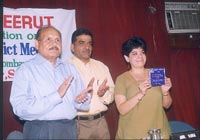 |
|
Sumita Dasgupta, Anil Rana
and Bhure Lal at the release function in Meerut
|
The document urges the government to address the issue of fund
availability for reviving the ponds. It proposes utilisation of
10 per cent of development funds available for each members of parliament
and legislative assembly for this purpose. It also recommends adoption
of alternate cropping system and cautions against widespread sugar
cultivation in the district.
Releasing the book, Bhurelal, Chairman Environment Pollution (Prevention
and Control) Authority (EPCA) for national capital region, said, "This
book underlines the need for protecting the water resources which
are vital for economic development of any country".]
"Lack of scientific data on waterbodies, has led to their indiscriminate
encroachment in the region. To stop such a destruction we have taken
up this study" says Anil Rana, President, JF.
Sumita Dasgupta, Coordinator, Natural Resource Management Unit, CSE
says, "An inventory of natural resources being prepared by an
independent, local group is immensely useful. It can play a significant
role in policy formulation and in mobilizing local groups."
BSNL organises a seminar on rainwater harvesting
On August 11, 2003, Bharat Sanchar Nigam Limited (BSNL), Tamilnadu
Zone organised a seminar on rainwater harvesting for civil engineers.
The objective was to impart training on the basics and design aspects
of rainwater harvesting, thereby facilitating them to implement the
system in all BSNL offices, staff quarters and other buildings under
the civil engineering wing of BSNL.
About 200 engineers participated in the seminar.
M Karmegam, Director, Centre for Water Resources, Anna University,
Chennai, in his key note address stressed the importance of eri-traditional
water harvesting system in Tamilnadu. He pointed out that there were
about 350 tanks (ponds) in and around Chennai at the rate of one tank
for every 3.3.square kilometre. He said, "Chennai's daily domestic
water requirement can be met by conserving just 35 per cent of the
total rainfall".
Speaking on the occasion the CSE staffer explained the design and
implementation aspects of rainwater harvesting. He also highlighted
the problems encountered during retrofitting and the precautions to
be taken while implementing rainwater harvesting system.
Shobnath, Regional Director, CGWB, AL Radhakrishnan., and P Subramanian
from Metrowater also spoke on the occasion.
Seminar in Mumbai
On July 23, 2003, the Indian Merchants of Commerce's Young Entrepreneurs
wing (IMC-YEW) organised a seminar on " monsoon hope" to
deliberate on rainwater harvesting. The target group comprised of
architects, engineers and industrialists. Inaugural address by Milind
Deora, Chairman, IMC-YEW was followed by screening of a short film
on rainwater harvesting produced by the Centre for Science and Environment
(CSE) and directed by renowned actress, Nandita Das. The water expert
from CSE spoke on the role of water harvesting in averting looming
water crisis in Mumbai.
The chief guest of the seminar Karun C Srivastava, commissioner, Brihan
Mumbai Mahanagar Palika, during his address revealed the corporation's
decision to reduce the water supply to the new buildings from 135
litres per capita per day (lpcd) to 90 lpcd. The remaining water has
to be managed by the citizens themselves by grey water recycling and
rainwater harvesting. Water harvesting has been made mandatory for
all new buildings as well. The occupation certificate for the new
buildings will be given only after verification by rainwater harvesting
cell of Brihan Mumbai Mahanagar Palika.
While speaking about the disincentive schemes the commissioner declared
that for those who have not implemented rainwater harvesting the price
of water would range from Rs 6.50 to Rs 10 per kilolitre (Kl). At
the same time the price would be Rs 3.25 per Kl for those who have
done water harvesting in their premises.
During the meeting Ashoke Maitra, Director, Times Foundation spoke
about their initiatives in bringing together the non governmental
organisations (NGO) and government bodies to a common platform to
promote the concept of rainwater harvesting. Vetran film actress Waheeda
Rahman narrated her experiences on convincing people to undertake
rainwater harvesting. She said, "Even my house owner told me
that she could provide additional tanker but not rainwater harvesting".
Mr. Vikram Jaisinghani, General Manager, Asian Paints, explained the
rainwater harvesting system in his factory and the way in which it
is used for daily consumption. Meeting concluded with a press conference.
For more details:
RK Srinivasan
water@cseindia.org
Model Projects 2002
CSE is constantly deluged with queries, opinions and ideas from people
who are concerned about the prevailing water crisis and are keen to
play an active role in managing water. The five model projects provide
the answers, at least to some of them. These also act as effective
tools to establish the fact that rainwater harvesting can be taken
up and implemented successfully in urban centers, by all concerned
individuals who are looking for a way to fulfill their own water needs.
As a part of the Centre for Science and Environment's (CSE) campaign
to spread awareness about community based rainwater harvesting techniques,
the centre has identified five model projects in Delhi, from among
those that have been designed by it. CSE has helped in the process
of implementation of these and has been monitoring their impact on
a regular basis. These five model projects have been constructed by
enterprising citizens who sought CSE's help to setup rainwater harvesting
structures in their colonies and institutions. The structures have
a distinctive geographical and geological characteristic; for example
the Mira Model School model has been constructed on a sedimentary
terrain and the Shri Ram School project is on a hilly terrain. They
also feature different forms of rainwater harvesting - rooftop harvesting
and surface water harvesting.
The following are the selected sites:

KANPUR MEETING
Kanpur city, which lies in the Indo Gangetic plain, has recently joined
the group of water scarce regions. The groundwater quality of the
region has deteriorated as well. A study done by the State Groundwater
Department clearly indicates the presence of high level of chromium,
due to the unregulated and unchecked discharge by the leather industry.
In order to find a sustainable solution, the Kanpur Development Authority
(KDA) took the initiative. Anita Bhatnagar Jain, vice chairperson
of KDA, while addressing the gathering informed that rainwater harvesting
for houses and plots measuring more than 1000 square metres has been
made compulsory in the city of Kanpur. On June 21, 2003, a one-day
workshop was organised to promote and popularise rainwater harvesting
(RWH) at Merchants Chamber Hall, Kanpur.
Divisional commissioner Mohammad Halim Khan inaugurated the seminar.
Architects, engineers and concerned citizens attended the event. CSE
was invited to make a technical presentation along with Prof H P Chowdhary
of Chandra Shekar Azad Agricultural University, Vipin Dutta from IIT,
Kanpur and R S Sinha from State Groundwater Board of Lucknow. CSE's
90 seconds public service advertisement about RWH was screened, which
impressed most of the participants. KDA has decided to show it regularly
in all the film theatres in Kanpur, to take the message to turn RWH
into a mass movement. Later, they also distributed CSE's technical
manual among the state ministers and officials. This easy to read
step by step guide, gives an opportunity to them to know all about
how to implement RWH systems in urban areas.
For further information:
R K Srinivasan / Salahuddin Saiphy
water@cseindia.org

The Nodal
Environmental Cell: A Defence Services-CSE Partnership
In a bid to spread awareness among the Indian army personnel on the
significance of water management and the tremendous potential of rainwater
harvesting, the Centre for Science and Environment has forged a tie-up
with the Defence Services. A new entity, the Nodal Environmental Cell,
has been set up that will include representatives from both the organisations.
Its main task will be to provide technical know-how to military professionals
so that they can implement this simple, yet effective technology in
the vast tracts of land-spread across the country--that are now managed
by the army.

Training
programmes on rainwater harvesting
For generating water literacy CSE have been extensively conducting
training programmes for stake holders ranging from individuals, representatives
from educational institutions, government organisations and industries,
engineers, architects, builders, contractors, plumbers and masons.
Keeping in view their needs and requirements, we have developed group
specific modules. Following is a glimpse of our earlier training programmes
organised during 2002-2003:
| Month |
Year |
Target Group |
| February |
2002 |
Professionals from industries (automobile, sugar, hotel and
construction), government agencies (Central Public Works Department,
Delhi Jal Board, National Capital Region Planning Board), academic
institutions (School of Planning and Architecture, Delhi School
of Engineering) |
| May |
2002 |
Plumbers and masons from New Delhi, Gurgaon and Noida |
| August |
2002 |
Professionals from construction industry (builders like Larsen
and Toubro Ltd (ECCO), Nirman Consultants, Ansal Housing &
Construction Ltd; architects from Dimension architects, Atrium
Architects and engineers form Delhi Public School) |
| December |
2002 |
Engineers in the defence services |
| February |
2003 |
Professionals in Jaipur |
|
RAINWATER
HARVESTING TRAINING PROGRAMME FOR
PLUMBERS AND MASONS AT ANDHRA PRADESH (June 4 - 15)
CSE conducted a one-day
training programme at six municipalities in Andhra Pradesh (Hyderabad,
Kurnool, Tirupathi, Vishakhapatnam, Guntur and Warangal) from
June 4 to June 15, following a request from the state government.
Plumbers, masons and municipality engineers attended the workshop,
whose average attendance was around 50 to 60. The workshops
were conducted in two sessions. The pre-lunch session explained
the theory and reasons behind rainwater harvesting. Plumbers
were introduced to various rainwater harvesting techniques,
and construction and cost estimate details. In the post-lunch
session, which consisted of practical details, plumbers
were given a model building and were asked to design water harvesting
structures for them. They were also asked to come up with cost
estimates.
|
|
|
|
The
training programe at Hyderabad
|
A
mason at Tirupathi explaining his design
|

Plumber and masons during
the practical session at Kurnool
|
Most of these municipalities have
been practicing water harvesting since 2000. One problem that
the commissioners and engineers have been facing is that their
water harvesting structures get silted up in no time. When the
CSE personnel went to the site to study the existing structures,
they found that they were not technically sound.
The
harvesting structures in all municipalities had the same design,
irrespective of hydro-geological conditions. Each such structure
cost around Rs 3,500. The structures are designed to harvest
surface runoff, which carries a huge amount of silt. These are
open structures, hence there is always a possibility of accumulation
of leafs and debris. The municipality engineers said these designs
were given to them by the groundwater department and they simply
implement them phase-wise.
|
A
sketch of the existing designs
|
An
existing rainwater harvesting
structure at Vishakhapatnam
|
|
|
|
This is the common design applied in
the rainwater harvesting structures for all six municipalities.
No space is provided for temporary storage of surface runoff.
Therefore, the amount of water that enters these structures
is far less than the runoff. There is no brick wall separating
the filtering materials from the sub-soil. So the filtering
materials gets mixed up with the sub-soil. Since the structure
is also not covered, debris and dried up leafs could settle
on them.
|
Now
in the newly-made structures promoted by the state government
under Neeru Meeru Programme, a small brick wall of about
9 inches is constructed around the recharge structure.
|
|
|
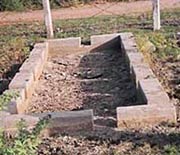
A modified recharge structure in Kurnool |
The
advantage in this structure is that they can, at least, be easily
identified for maintenance purposes. On every third Saturday
of the month, under the Clean & Green programme, engineers
scrape off the top sand layer and replace it with a new one.
But then again, the main filtering materials are not serviced
properly.
Among all the municipalities visited,
Guntur municipality has best water harvesting structures.
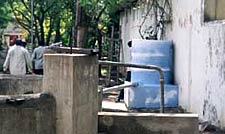
Diversion
of roofwater to an existing open well after proper filtration
in Guntur
| In
the Guntur municipality, three of the six existing water
bodies were revived under Neeru Meeru Programe. Encroachments
were removed and the water bodies were neatly fenced in.
Stormwater is diverted to these water bodies |
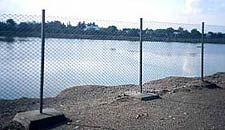 |
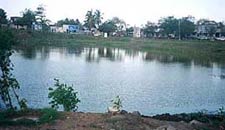 |
In the Warangel municipality, the CSE
personnel asked the masons to design a sustainable rainwater
harvesting structure that takes care of the existing drawbacks.
This structure will approximately cost Rs 5,000.
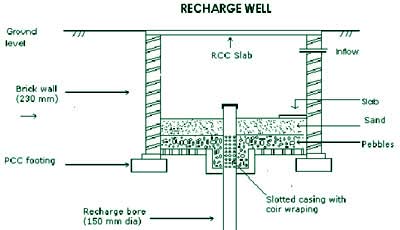
Rainwater
harvesting structure designed by masons in Warangal
Since reinforced cement concrete (RCC)
rings of 4 ft diameter and 1ft height are easily and cheaply
available in Andhra Pradesh, the masons think it will be practical
to use cement rings instead of bricks for the wall. This will
reduce the cost of the structure dramatically.
The
main advantage of providing a recharge bore inside the recharge
well is to transport the rainwater to the aquifers. The existing
structures can only replenish the soil moisture and most of
the water gets lost by evapo-transpiration. These newly-designed
structures can be covered with perforated slabs to prevent entry
of debris into the structures. Since the filtering materials
are separated from the sub soil, maintenance of the structure
is also easy.
|
 |
Miscellaneous services
Every Friday between 2:00 pm to 6:00
pm, Centre for Sceince and Environment (CSE) provides detailed technical
guidance to interested individuals and institutions to implement rainwater
harvesting, as a part of Miscellaneous services programme. If you
are interested in setting up a water harvesting system at your place,
please attend our Miscellaneous services programme:
Contact address:
Miscellaneous Services
Centre for Science and Environment
4th Floor, Core-6 A
India Habitat Centre
New Delhi-110 003
Phone: 011-24645334/5
Email: water@cseindia.org
Meeting on protection of urban
waterbodies
To promote the movement to revive dying urban wetlands, CSE organised
a workshop on October 3-4 in New Delhi. "Our objective is to
motivate the urban population to understand the manifold uses that
these decaying water bodies once served, and to emphasise the urgent
need to protect and revive them," specified CSE director Sunita
Narain. Individuals and organisations from across the country, who
have made significant efforts to conserve ailing lakes, ponds and
tanks in their respective cities, shared the experiences. Case studies
from Udaipur, Rajasthan; Delhi; Chennai, Tamil Nadu; Srinagar, Kashmir,
Uttranchal and Kolkatta, West Bengal were presented. Technical, legal
and institutional experts also took part in the vibrant enriching
dialogue.
| |
Core
Committee
-A Vaidyanathan
-Bharath Jairaj
-Devaki Panini
-Gurunadha Rao
-Mohit Ray
-M K Ramesh
-Sandeep Virmani
-Shyam Parekh
-Sunita Narain
-Tej Razdan
-Videh Upadhyay
-S Vishwanath |
|
CSE has constitiuted a core committee to facilitate dialogue and action
among the litigants as well as the members of civil society (See box:
core committee). The twelve- member committee will work on the issues
flagged during the meet. The emphasis will be on strengthening the
role of the civil society in protecting urban waterbodies.
CSE LakeNet
CSE LakeNet is an e-group to share experiences, opinions and ideas
on the protection of urban waterbodies. CSE LakeNet is a platform
that will highlight topical themes on urban lakes and allows members
to discuss relevant issues threadbare. The objective of this e-group
is to develop a comprehensive, unbiased strategy on what needs to
be done to protect these once bountiful lakes. Interact, network and
help us sustain a lively and constructive dialogue.
http://groups.yahoo.com/group/cselakenet |
|






